#it's always fun to make a planeswalker design for a given mechanic
Explore tagged Tumblr posts
Text

Art by AzraelLaVolpe
Card transcription
Davriel, Crossroads Dealer 3B Legendary Planeswalker- Davriel [mythic] +1: Whenever an outlaw you control deals combat damage to a player this turn, you may pay 1 life. If you do, create a Treasure token. -3: Create a 3/3 black Demon Mercenary creature token with menace. -6: Target opponent opponent discards their hand. If they discard fewer than seven cards this way, draw a number of cards equal to the difference. 4 loyalty
End transcription
#original post#mtg#custom magic card#outlaws of thunder junction#this is a card that's been sitting in my files for a while so i finally found art for it#it's always fun to make a planeswalker design for a given mechanic#for outlaws davriel felt like a great fit since he's clearly a warlock#even though this card itself has no relation to warlocks it still works
6 notes
·
View notes
Text
Ikoria Companions and Commander
I know this is not my usual content but I need to rant about this somewhere or I will explode. If you don’t care about MtG then feel free to ignore.
TLDR: Salty Commander player rants about the new Companion mechanic.
Ikoria, Lair of Behemoths, the latest set of Magic: The Gathering has been fully revealed and a new mechanic in this set is Companion. To summarize, these ten new Legendary Creatures can be played in your deck as normal, but if you build your deck in a specific way, you can have these cards be your Companion, which is a card that is outside of your main deck that you can play at any time. Since these cards were made with Standard in mind, that means these function as your 61st card provided you built your deck to meet the requirements of the Companion ability. Wizards of the Coast (the creators of MtG) have stated they did this to allow Standard players the option of playing similar to how Commander plays, since Commander is now one of, if not THE most popular format right now. They even stated that these companion abilities will be legal in Commander, and Companions will function as your 101st card AND sort of a second Commander.
And this is where the problem starts. Companion was made with Standard in mind, not Commander. And while these Companion restrictions are fine in Standard, in Commander, they are not created equal.
And that is what I am doing today. I am looking at each of these Legendary Creatures and judging them solely on their viability as Companions. I will be doing this by seeing how many current Commander decks they could be the Companion of and ranking them into a tier list.
A Tier:


The Companion restrictions of Umori and Keruga bring about some interesting deckbuilding challenges, but does very little to effect what Commanders they can be Companions for. All Commanders that have black and green in their color identity can have Umori as their Companion (even Lord Windgrace if you name Planeswalkers) for a total of 98 legal Commanders and 42 pairings of the C16 Partner Commanders.
Keruga has less total legal Commanders, but that has more to do with there being less Commanders with both green and blue in their color identity. In fact there is currently only one green/blue commander with less than 3 CMC and that is the Partner Commander Thrasios. This gives Keruga a total of 87 legal Commanders and 28 legal C16 Partner pairings.
B Tier:


The restrictions made by Obosh and Gyruda force you to build a deck with only odd CMC cards or even CMC cards respectively. As expected, this cuts the number of legal Commanders quite a bit. Obosh comes out ahead with a total of 60 legal Commanders and 16 C16 Partner pairings, while Gyruda only has 53 legal Commanders and no C16 Partner pairings.
C Tier:



It’s at this point where the Companion restrictions are not just heavily limiting deckbuilding, but also the number of legal Commanders. Zirda only has access to a total of 30, Jegantha with only 23, and Kaheera with only 14.
We also see how because of the differences between Standard and Commander, the Companions like Jegantha are heavily effected. While all of the other Companions only had two colors in their identity, and were legal in any deck that had those colors, because of Jegantha’s tap ability, it has all five colors in it’s color identity. This isn’t a problem in Standard, but in Commander, this means that Jegantha is only usable in five color decks, whether or not it is used as a companion.
D Tier:

Because the Companion restriction of Lurrus makes it only able to have permanents of CMC 2 or less, this means that there are only 2 legal Commanders for it (Karlov of the Ghost Council, and Ayli, Eternal Pilgrim). It actually upsets me that Lurrus only allows for 2 CMC permanents, but it has a CMC of 3. I suppose if its mana cost was reduced to only 2 or its ability allowed for 3 CMC permanents it would be too powerful for standard, but that is why designing the Companion ability for standard and allowing it for Commander was not a good idea. And we see that taken to the two logical extremes with the last two Companions.
F Tier:

This is it. This is the WORST companion ability for Commander. Yorion has ZERO legal Commanders, but it has nothing to do with the Commanders themselves, but instead with Commander as a format in general. While Standard has a minimum deck size of 60 but could theoretically have as many cards as you want, Commander must have EXACTLY 100 cards in the deck, with one of them (or two in the case of Partners) being your Commander.
All the other Companions we’ve seen so far could always get more legal Commanders in the future. But, given the restrictions of the format, it is, and forever will be IMPOSSIBLE to have Yorion as your Companion. But at the very least, you can have Yorion in the 99 or even build around it as your Commander. The next Companion isn’t so lucky.
S Tier BANNED:

While the Commander format works against Yorion in a cruel way, the format works WITH Lutri in an even more cruel way. Lutri’s restriction makes it so all nonland cards in your deck must have different names. In Standard, that provides an interesting deckbuilding challenge, as to make your deck more consistent, you usually want multiples of your best cards. Commander however is a singleton format, meaning every card in your deck, barring basic lands and a few other exceptions, MUST be different. In the Commander format, Lutri’s restriction doesn’t restrict anything.
If Lutri was allowed to be your Companion, it would be an auto-include for every deck that had both blue and red. Of the 32 possible color combinations you can have, 8 of those would have the advantage of getting a free Companion without having to change anything about the deck. I mentioned earlier that Umori and Keruga had access to nearly all of the Commanders that could run their colors, but they at least still had to build the deck with the Companion restrictions in mind. Lutri has no such handicap. As a result, the Commander Rules Committee has universally agreed to ban Lutri. But because the RC doesn’t like complicated bans, they decided to ban Lutri entirely. It cannot be your Companion. It cannot be your Commander. It cannot be in the 99. It cannot be used at all.
And the worst part about all of this? Lutri was one of the FIRST Companions that were revealed. Lutri’s ban was made about a week ago, while the final Companion (Yorion) was spoiled today. If all the companions were revealed at the same time, would the Rules Committee have even allowed Companion to be used at all, knowing how incredibly imbalanced this mechanic is?
If it wasn’t clear by this point, I am a Commander player, not a Standard player. And while I love the new Ikoria set as a whole, the Companion mechanic, which I was initially cautiously optimistic about, has left a bad taste in my mouth. I get it, this is a Standard set, not a Commander product. Hell, alongside Ikoria, WotC is releasing this years Commander product early! And it’s Ikoria themed!
WHY AM I SO SALTY?!
Well, it is because I feel the Companion mechanic is a broken promise from WotC. They told the Commander players not to worry, that Companion would be fine in our format. They then proceeded to reveal the most viable Companions first along side one that was insta-banned as soon as it was revealed. Then they trickled out the remaining not as viable Companions and capped it off with the one that can never be a Companion in our format.
In my opinion, the Companion mechanic should be banned in Commander all together. But the Companions themselves should all be allowed as Commanders or usable in the 99. None of them are broken in that regard, and they are all fun to build around as Commanders. But I feel that this isn’t going to happen, as none of them are broken as Companions either. And even though I made this list with the intent of showing how many legal Commanders work with each Companion, that actually isn’t a good method of determining how good any of the Companions are! The C and D Tier Companions don’t have that many legal Commanders compared to the A and B Tier ones, but the ones that ARE legal for the lower Tiers synergize far better than most of the legal ones for the higher Tiers.
And then there are poor Yorion and Lutri. One unable to be a Companion in Commander, and one banned from the format entirely. And so long as the Companion mechanic is legal in Commander, neither of them will ever Companion anything in our format.
END RANT.
22 notes
·
View notes
Text
My OCs (A Masterpost)
So, you wanna get to know my OCs, eh? Great! That’d make my day! I appreciate your interest more than you know! :) I have a lot of OCs, I will admit, many more than will ever show up here on tumblr. I will only include, in this post, those that have had drabbles written about them and/or people have expressed interest in. The current number of OCs featured on my tumblr is 12; Milo, Anton, Jackson, Valerie, Elias, Risa, Samson, Cindy, Moe, Damien, and Marcelo.
Character bios are below the read more, because, trust me, there is a LOT more to read!
Milo’s Story: A Complete and Utter Mess
Milo O’Malley He’s lean, he’s definitely not mean, and he’s nearly exactly five feet of skin and bone and little else. Beaten down repeatedly through his life, this kid (who doesn’t even look like a kid anymore) resigned himself to a life of harsh, relentless work until his body inevitably gives out on him when he turns 26. Oh, except, it seems a very powerful tiger sprite is trying to possess his body, and he actually doesn’t want to die. And he’s been “adopted” by a giant pick-axe wielding dad-friend named Jackson, who also insists he lives on. Milo isn’t much of a looker, not anymore, with a gaunt, ghoul-like face, dull green eyes, and a shaved head (easier to keep clean when you don’t really have a place to get clean). He is, as I mentioned earlier, five feet tall, thanks to malnutrition through his early years, and dangerously thin. He’s of Irish descent, though his pale skin has long become a sickly gray. After living with Jackson for a while though, his red hair’ll grow out a bit and he’ll get back some of that snow-white European paper skin. As far as he knows, Milo is straight, but he’s never really been in a relationship before. Milo’s Playlist
Jackson Pitolua Jackson is the ideal dad-friend. He’s kind, he’s caring, protective, intelligent, and has a witty sense of humor. He’s been through some very rough times in his life, has had his fair share of terrifying, nightmare-inducing experiences, but this refining fire has left him who he is, and he doesn’t soon forget it. Not all his emotional wounds have completely healed, though, but at least his coping mechanism is seeking to help others as much as possible. As much as he’s grown, he’s still young, and he still hungers for adventure, doing so regularly as both a hobby and a profession. This has led him to meeting and literally adopting Anton, and figuratively adopting Milo. In terms of physical descriptions, Jackson is 6-feet-10-inches and over 200 lbs of pure muscle, with short black hair, a large nose, warm brown eyes, and wide smile missing at least one tooth. His Polynesian descent grants him darker skin, and he’s gotten his fair share of tribal tattoos, with one climbing up his arm to just under his left ear, and another adorning his right leg. His adventuring has led him to be in need of a patron, and so he has chosen one, his allegiance to his Samoan goddess of choice emblazoned all over his back. If he were to be put into any Dungeons & Dragons class, it would be barbarian, because he favors little armor and wields a pickaxe that weighs twice or perhaps even thrice that of Milo. Jackson is straight. Jackson’s Playlist
Anton (Pitolua) Anton is a bit different from others, in that he is not human. He’s from a race of humanoids known as the Night People, carnivorous humans with a very base, tribalistic society. Anton left it in a heartbeat to go with Jackson when he was around the age of 17, after hearing all the wonderful, magical things the modern world had. Anton had his first taste of indoor life and decided he would never go outside ever again. Jackson didn’t allow for this, but Anton has remained rather partial to his static, sustained environments. Anton is a strange one in terms of personality, having lived in a competitive survival situation his whole life and suddenly plopped into one where everyone’s on fair ground. He’s picked up the english language quickly, but he’s still working on his mannerisms, so he can often come off rather cold or harsh, but he means well. He’s protective of his new family, and would give his life for them in a second. Appearance-wise, I am still undecided. I’ve sketched multiple designs, but I haven’t found one that I really enjoy yet. Some features I have decided on though are sharp claws instead of nails, sharp teeth, clawed, long-toed feet with rotating ankle joints and opposable thumbs. Distinguishing features for Anton specifically are his long, black hair and the long scar down his left arm from a nasty fall he took in his youth. Anton, sexually-speaking, is very young and not sure about anything and, for now, forbidden from the act of it by Jackson, who’s nervous he might take after the rather… animalistic sexual habits of his people. Luckily, Anton plays Fortnite and doesn’t get out a lot, so Jackson doesn’t need to worry too much (yet).
Valerie Floraison A wood elf in a modern world, Valerie was raised mostly in Detroit with her nine sisters. Their family made trips back and forth between home and their parents’ home in another realm throughout her childhood so she could still retain her culture. Her family struggled financially all her life, a combination of poor decisions and bad luck, when left Valerie hungry for a life outside of the projects. She moved to D.C. after graduating top of her class at a college in the other realm, and joined the newly-publicized Magic Affairs Agency, becoming head of resource management in no time. She’s got a fiery, stubborn spirit about her, and it’s easy to see her as shallow and materialistic, but she really does care about people. Well, except maybe Jackson. Her sister was engaged to Jackson, and died fighting with him against a manticore. Valerie blames Jackson for her sister’s death. She’s not quite over it yet. As courtesy of her job and career, she’s quite good at wearing a pleasant face, even when she may or may not desire to strangle you. She has a habit of getting a bit physical when angry, never anything beyond a slap, and she does tend to feel bad about it afterwards. Valerie is almost exactly 6 feet tall, with a thin and willowy figure. She has those long elf-ears, which bear a moderate number of piercings each. She has darker skin with long, wavy black hair that’s usually down, falling over her shoulders, and purple eyes. She favors the finer things in life, so it’s rare that you’ll ever see her out of a dress or not wearing heels. On her left hand is a small rune she had tattooed there that grants a permanent illusion perfectly-applied make-up on her face (no, this did not come cheap). Valerie, in college, double-majored in finances and illusion magic, with a minor in magical cloth manipulation. If she’s not wearing Gucchi, she’s wearing her own couture.
Elias and the Terrible, Horrible, No-Good, Very Bad Life
Elias Benson Native to the lands of Utah, Elias has never really had an outstanding good time in his life. His family never liked him and kicked him out of the house before he was a legal adult, which resulted in him moving across the country on his own before he was really ready. He’s had relationships before too, and none of them were healthy. He’s a gentle soul, but the world hasn’t really given him a chance to prove it, so he’s turned out to be a bit of a punk, and a lot of an idiot. Even so, he’s a truly good person, even if his language (and observable intelligence) belies it. Elias, before he meets the bounty hunter Risa, is about 5”9, and is pretty gaunt. He’s not quite Milo-levels of emaciation, but he’s not exactly looking great either at around 130 lbs. He’s got short, curly brown hair and big, green eyes, and a little nose stud on the left side. Bruises around his neck were pretty much perpetual from his girlfriend. He also was never terribly clean, so he was usually kinda grungy. After meeting Risa, things more or less took a sharp 180–he got and stayed clean, and bumped his weight up to almost 200 lbs through healthy diet and strict workout regimen. If he gave thought to it and knew it was a thing, he’d identify as asexual or straight.
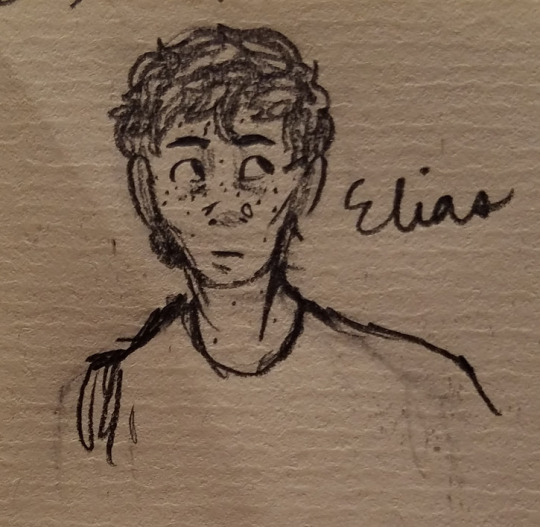
Elias’ Playlist
Risa Literally out of this world, I like to describe her as a psychopath who accidentally gave herself a soul–because she kinda did. She’s from another planet in the future in a different universe, and was originally a complete sociopath. Not the “mwahaha I like murder because it’s fun” kinda thing, but she just didn’t feel things the same way or at all as other people, literally incapable of most emotions. She was wicked smart though, and after many years of learning about machines and how to be a witch, she complete switched her weak, fleshy body for a metal one and a computer chip brain. Due to an error on her part, however, this robot brain opened up neural pathways for her to experience and use emotions other than want and annoyance. Not that that slowed down her bounty hunting career in the slightest. She’s a planeswalker of sorts, meaning that she’s particularly good at finding her way around the multiverse, and takes advantage of it and the many job opportunities presented because of it. She’s a grade-A badass, also a bit op, and she’s lets people know it. She (kidnapped? Adopted? Enslaved? Took in? There is no good word for how she got Elias) got Elias as her henchman because she was bored and accidentally got attached. Risa is cold, calculating, greedy, and apathetic unless there’s money in it for her. She also has a sense of humor and sarcasm that usually smacks harder than a bullwhip. When she’s not on a job or in a rush, she can also be incredibly, horribly, awfully petty, and takes advantage of her often-if-not-always superior resources to smack down her enemies like flies. She’s a very practical person, and will always choose the most logical pathway in any situation. Risa is lesbian, but the only people she’s ever been attracted to in any way at all is her computer wife Carol, and a giant, sentient, anti-orbital gun she met once on a distant world. Risa is the most difficult to describe in words for me. She’s designed her body to be lightweight but incredibly strong, with minor force manipulation. Thanks to a very expensive coat of paint and arrangement of parts inside her, if she goes ten minutes without direct observation, she becomes completely invisible and partially intangible. She’s not powered by fusion or fission, but rather, a captured god that resides in an enchanted jar in her chest cavity. Her body lacks a lot of humanistic features, being mostly a very smooth, rounded head with antennae on either side that resemble ears, and often move like them too. It wasn’t until she got Elias that she finally installed a proper mouth on herself as well. Risa’s Playlist
Samson Callidan Samson is a very gentle soul who speaks softly, and tends to not speak for long either. He’s wise and observant and a very good listener, because likely, no matter who you are, he cares, at least a little. He had a harsh mother who taught him whats-what, growing up in deep Texas. He has the ability to force people to do as he says, as long as he’s commanding them, like a built in command spell from D&D. Luckily, his mother knew him better than he realized and she was always able to stuff something in his mouth and taught him that his power wasn’t to be misused. Samson is not a young man anymore, but is old, and his parents would say he’s been old since he was about twelve. He’s a religious man, a devout member of the Church of Jesus Christ of Latter-Day Saints, though he didn’t join until well into his twenties, after mission age. He still has done his fair share of traveling, and some of it he even enjoyed. One trip into another realm left him handicapped, with only one functioning eye, and he’d say in a heartbeat that that was the worst time in his life. Luckily, his second wife, Cindy, thinks eyepatches look cool. He and Cindy live alone, way up in the mountains of Utah in a tiny little cabin he and she built together. They have had no kids together, but he plays grandfather to Cindy’s children from a previous marriage of hers. Samson is a gentle giant, roughly 6’’5 and of various European descent. He has tan, leathery skin, with a kind, gray eye, and his hair has long-since grayed, though once it had been a lovely gold. He’s built thick, with a strong figure that Cindy keeps filled out, and despite his age, he’s retained a generous portion of strength from his youth. He’s got a large scar that stretches across his face, going over his left eye, nose, and just barely missing his mouth. His nose, once handsome, is disfigured at the tip, and his eye is a badly-healed, still-freshly scarred pit in his eye socket, though one does not usually see it beneath his eyepatch.
It’s Too Damn Cold To Be A Superhero Today
Damien Lowry Yet another upcycled character, I’m still kinda pulling off the cobwebs and dusting him off, so his backstory may be subject to change. But, as a person, Damien is stubborn as a mountain, and the kind of person whose idea of ‘relaxation’ is more work, but work he wants to do. He’s pretty easy to get along with, but he won’t tell you if he doesn’t like you, he’ll just avoid you. He bounced between homes as a child, traded constantly between his sweet-yet-frail grandparents, his constantly sick or injured mother, or his perpetually drunk father. He’s pretty quiet, a result of too much time spent alone, or too many voices in his head. The voices, fortunately, give him a handful of powers to use as he pleases, and he does so, wielding them under the guise of the superhero, the Alchemist, so named for his ability to summon substances at will. Unfortunately, the power is very specific, and Damien never graduated highschool, so chemistry is a bit foreign to him. But he manages. Damien is mostly only interested in women, a couple men catching his eye throughout his life, but nothing ever really progressed further than crushes, and he’s never had a steady relationship. Damien stands at roughly 5’‘10, and while he’s not starving or emaciated, he’s still on the skinny side, but is deceivingly strong. He has some Native American in him, giving him darker features, including brown eyes and shaggy, usually un-kept black hair. His teeth are noticeably crooked and slightly yellowed, so he usually doesn’t smile with his teeth. He’s built sturdy, and hey, maybe someday he’ll fill it out.
Marcelo Blackwood Marcelo is, honestly, not that different from most super villains. He’s disgustingly rich, wicked smart, and seeks power. He does take the path less traveled from here though, because Marcelo is not mean nor conniving nor evil. He’s a rather nice mayor of a small town in Alaska that’s best well known for having the only superhero in upper North America. The superhero’s name is the Alchemist, and he has but one main foe: the Roman. Who is the Roman? Marcelo is the Roman. By day, he plays the role of the town mayor, a kind, courteous fellow with more money than he knows what to do with, and by night, he is a super villain, blowing things up and robbing banks. What is his motivation? Well, it’s his hobby. Keeps things interesting. His wife is his greatest supporter and literally his partner in crime. Marcelo is, despite all this, a very kind person. He’s very smart, he’s patient, and tries to do his best by the citizens of his town. Even when he’s playing the role of the Roman, he avoids true wanton destruction or harming innocents, bystanders, and law enforcement. Mayor Blackwood is 6’‘10, with pale skin, piercing blue eyes, and always well-styled black hair. He has a perfect nose, a nice jawline, and is all around a strikingly handsome fellow. He may be in his late thirties, but it’s hard to tell. The mayor is always dressed well, rarely dressed down any lower than business casual, and all his clothes are custom-tailored. As the Roman, he wears boots with thick soles so that he is 7 feet tall, and wears a expertly-made and expertly-applied fake beard under his Roman centurion helmet. The helmet also has a visor to further hide his identity.
A Menagerie of Disasters (Everyone Else)
Moe Moe is an older character of mine, and for the writing blurb I used him in, I was really recycling him just for the specific scene in mind. As of now, there isn’t much to say about him. He’s a pained, mentally-distressed individual with a very rowdy demon trapped in his mind.
---
That’s all, folks!
#my ocs#my ocs (a masterpost)#masterpost#oc masterpost#burtlederp writes#burtlederp's characters#burtlederp's kids#a menagerie of disasters#all of them#burtlederp#burtlederp posts
5 notes
·
View notes
Text
Throne of Eldraine Draft Format Review
Theros Beyond Death is fully upon us, and players are starting to discover the ins and outs of this new Limited season. But before I dive fully into that, it’s time for one final goodbye to the previous set, with my Throne of Eldraine draft format review. Here are the criteria I evaluate:
Speed - Consisting of its Tempo, Aggression, and Explosiveness
Variety - Consisting of its balance between the Colors/Archetypes, Threats to Removal, & Deck Strategies
Depth - Consisting of the depth within individual cards, within archetypes, and within the metagame as the whole
Fun - Consisting of the Flavor & Theme, the Gameplay itself, and the amorphous “X-Factor”
I’ll also go through my thoughts on the themes & mechanics, any noteworthy decks, notes on draft strategy, and give it a final grade.

Art: Jana Schirmer
Seriously, this picture is so much a mood.
Speed
Tempo - Decks in Throne of Eldraine varied wildly, with some hyper aggressive decks getting blazing fast starts, and some slower control decks spending the first few turns just responding. That said, the risk of not having any low curve is very real, even if just to stall, so I’d say the tempo of this format is actually fairly fast, as the games start off quite quickly. You want your curve to start around turn 2.5 on average, to avoid being left in the dust.
Aggression - Despite the presence of some archetypes that lean aggressive, most of the mechanics actually push the opposite direction. Adventures incentivize getting maximum value out of your creatures, so most of them won’t get played on curve. That said, many of them are combat tricks, so combat matters more in this format than usual. Adamant had little effect. But the real story here is Food. Food, with its persistent ability to regain 3 life a pop, extended games, and gave slower decks plenty of time to make up for slow starts. That, combined with some really good defensive creatures and strong removal, skewed the overall feel of the format much slower than I think anyone anticipated.
Explosiveness - If anything, this format is defined by overly slow, grindy games. So much so that it was completely possible for games to come to a complete standstill and eventually end by one deck naturally milling itself out. (Which is a miserable way to go.) Some decks were capable of explosive quick wins, and there were a few near-unbeatable bombs (all three Planeswalkers come to mind). But overall, this was a format lacking in game-ending power.
Variety
Balanced Colors/Archetypes - As a whole, all colors feel playable. Green/Black as an archetype is slightly stronger than the others on balance, and Blue could come up with ridiculous control decks at times. But no color pair felt unplayable, even Red/White, which has been consistently the weakest in recent sets. You had to get deep into Knights (giggity?) for it to work, but if you did, the payoffs were there.
Balanced Threats to Removal - The removal in this set was strong. Every color got cheap, effective removal, though White/Blue struggled to deal with certain types of threats, namely those with passive abilities like Irencrag Pyromancer and Mad Ratter, of which there were a lot in the set. But it wasn’t a huge issue overall. The removal felt very strong in general. Even “expensive” removal like Bake Into a Pie was well-worth the mana, given the added bonus.
Balanced Deck Types - Between aggro, midrange, and control, I am happy to report that all major deck types had a presence in the format. I found midrange and control to be slightly more effective than pure aggro, since board stalls were fairly regular occurrences and you need something to push through. Blue-based mill decks were heavily overrepresented in Arena draft, and the resulting digital format was markedly worse than in paper.
Depth
Individual Card Depth - Throne of Eldraine felt a little more linear than most previous sets, with most cards having a clear best deck. Where it did well was on creature typing, with cards like Weaselback Redcap able to fit into both the Knights deck and the non-Humans deck. Similarly, some creatures with effects made use of their typing to work in multiple ways, like how Tome Raider combines with Draw 2 synergies and non-Human synergies. Witching Well was an all-star in this regard, fueling the Artifact deck and the Draw 2 deck effectively, making it much better than it appeared at first blush. But these examples were more the exception than the rule, with most cards either being just generically good so you’d always run them regardless or being specific to one deck.
Depth Within Archetypes - Most archetypes had a little wiggle to them. The strictest build was Red/Blue Draw 2, which really needed at least 2 good payoffs (like Mad Ratter or Improbable Alliance) to work, and Blue/Black control really wanted a Merfolk Secretkeeper or two (or three or four) to activate some of its pieces early and enable the mill win. I’d say the format was pretty average on this front, with some archetypes feeling a little narrow, while others felt pretty open.
Metagame Depth - Other than the occasional monocolored build, it was pretty easy to feel out what deck you were going against pretty quickly, and the metagame stabilized very fast. My feeling is that matchups were pretty consistent, but it’s unclear if that’s backed up by any actual fact. But in my head, for example, White/Blue generally beat Green/Black, but lost to Red/Blue. Etc. Don’t know if that’s actually true, but even if it isn’t, the metagame didn’t feel particularly deep, compared with some of the formats over the last year.
Fun
Flavor & Theme - Surprise surprise, this is the one place where Throne of Eldraine knocked it out of the park. The flavor and theme was spot-on, and it was enormously fun to mix and match various adventure & fairy tale tropes. In fact, I’d argue that the flavor and theme was a huge part of what made this format fun to play at all. The imaginative and whimsical flavor is the clear high point of the set, no question.
Gameplay - As hinted at above, the gameplay was not the high point of the set. Adventures played really well, and I’d love to see those return again, and I actually enjoyed the mono-color draft, which gave it a slightly different feeling than most other sets. But the games stalled out with regularity, and the omnipresent lifegain of Food could make it incredibly difficult to close out. Any format where naturally drawing your deck is a real thing that happens has a problem.
The X-Factor - Combining the flavor & gameplay, let’s just say this set was really variable. Some games & some matchups felt really fun and dynamic, while others were a miserable slog. This was particularly true on Arena, where it was too easy to force a Blue mill deck or a good Black/Green food deck, which were the two most problematic archetypes from a gameplay perspective. The paper metagame had a little more aggro to balance it out.
Themes & Mechanics
Adventures - Adventures were the highlight of the set, as far as I’m concerned. They were fun and flavorful designs, but were also incredibly powerful, on average. The cards were highly flexible, adding up to more than the sum of their parts, and were an incredible way to make sure you had a good mix of spells & creatures in your deck. I’d love to see Adventures return in a future set, though I’m curious how much design space they actually have. On the one hand, it seems like it should be enormous, because you can combine spells & creatures in basically infinite ways. On the other hand, it could be difficult to design cards where the spell half and the creature half complement each other to form good play patterns. Either way, these were a hit.
Food - I may be alone in this, but I sincerely hope Food never returns, at least as a major mechanic. (I’d be okay with an occasional Food card in supplemental sets, or something.) But this mechanic was honestly not as interesting as it seemed at first. Unlike Clues or Treasures, which both played well, Food ended up mostly serving to prolong games unnecessarily. In a format prone to board stalls to begin with, this was not a good thing in my book. It’s possible that it will work better in a faster format, but honestly, I’m okay if we don’t get Food again.
Adamant - I really liked the play of Adamant. It’s the non-flashy “workhorse” mechanic of the set, but those are such an important part of what makes a set work. Adamant served a useful purpose, encouraging decks to lean on one color more than another, and made for interesting decisions during draft. It requires a mono-color focus to work, but I’d be happy to see Adamant come back in the right set.
Knights - Knights have always been a fringe tribe, which is strange given that Magic is a fantasy property. I really enjoyed the way the Eldraine world was constructed with its knights in each color, along with their corresponding virtues and styles, but it was smart to consolidate them in just 3 colors for Limited play. The one issue I had here was that the Knights lacked a particular mechanical cohesiveness, generally just being the “aggro” tribe and having some one-off synergies here and there. I’d love to see Knights return sometime to get a little more direct focus.
Non-Humans - Like Knights, the non-Humans theme lacked a strong mechanical identity, and served mostly as a catch-all term to form Limited archetypes around. It seemed like a “this set” need to have an opposing tribe to counterbalance Knights. I would be surprised to see this again soon.
Monocolor - I sorta covered this with Adamant, but Monocolor was a theme independent of that one mechanic, with heavy mana requirements, lands that rewarded going deep on a color, and lots of Artifacts to ensure there was plenty to go around. This was one of the first sets where I’ve been able to successfully draft mono-color decks, and it was really enjoyable to be able to do so. They’d be wise to revisit the same tricks the next time they want to do a mono-color focus.
Noteworthy Decks
Blue Mill - Oh, the bane of my Arena drafting experience the past 3 months. How you taunt me. I mean, what is there to say here? In Arena, the strategy is just grab every single Merfolk Secretkeeper that came your way (it was relatively trivial to get 3-5 of them), and have the rest just be removal & other defensive creatures to gum up the board until your opponent decked. In paper, it was a little harder to pull off, but it would still happen with an early Folio of Fancies or just some good luck. Sometimes mono-Blue, sometimes paired with Black for cards like Drown in the Loch and other removal. This was a truly miserable deck to play against, to the point that people were reportedly running more than 40 cards in their decks just to preempt it. I’m happy when a milling deck is possible. But this was just too easy to spam. Hopefully Wizards learned their lesson and also is fixing their draft bots.
Seven Dwarves - Just as the name implies, this deck is entirely centered around the card Seven Dwarves. Grab as many copies as you can, and go to stomping town. Most often paired with Green to find some non-Human synergies, plus that’s the best other color for aggro, and this truly is an aggro deck. It comes together more than you’d expect, since the dwarves are a low pick if you’re not looking for them.
Glitter Princess - This deck was typically a variant of White/Blue Artifacts & Enchantments, except this build centers on getting a Beloved Princess on the field and enchanting it with All That Glitters. With just a few more pieces, the princess becomes a near unblockable threat that completely outscales both Red & Green removal in short order. The other colors all have good answers, so having Blue mana open to counter their attempts is a crucial component to this deck, and part of why I rarely saw it in other color combinations. There is a White/Green version with Tall As a Beanstalk, but usually that deck wanted to center on Adventures, and didn’t have room for the Princess or Auras.
Strategy Notes
Throne of Eldraine drafts start off pretty straightforward. If you’re not going to try to spam one of the obnoxious decks above (I kid, mostly), the usual pick order of bombs - removal - evasive creatures usually is the way to start. Once you have a sense of what’s open and where your color pair is leading you, however, things change dramatically. Finding the needed payoff cards becomes top priority, as they are few and far between.
For example, once I’m feeling Red/Blue (I don’t even have to be committed, just considering it), I will take a Mad Ratter over just about anything but the most absurd of bombs. Even over removal like Slaying Fire. In the same vein, if I’m in pack two and have drafted a decent White/Green Adventures deck, I will take a Wandermare over basically all removal, because there is likely to be more removal, but that may be my only really great payoff I’ll see. And the games where that card singlehandedly wins will be worth it. The trick is not to speculate on payoffs too early, because it’s easy to get attached to them if you pick them right away. But once you’re thinking the archetype is available, the payoffs become an enormous priority. That small pool of cards will often be the deciding factor against board stalls.
Monocolor decks are possible, but you’re still most likely to need to draft a second color to ensure you have enough playables. Don’t take bad Artifacts just to force monocolor. If you have strong one-color payoffs, consider trying to draft with that as a primary and “splash” your second color. It’s often correct for your deck to lean ⅔ or so towards the main color, rather than a more even split. The mana base should reflect this, leaning 10-7 or 11-6, though I usually wouldn’t skew much more than that unless my second color was truly just a splash. On the flipside, two color decks with a third color splash are also possible, but a little less common than usual.
Final strategy note: Adventures are good. Nearly all of them are better than they look at first glance. If you’re comparing two cards that seem evenly matched, but only one of them is an Adventure, picking the Adventure will be right more than half the time. The flexibility and inherent card advantage is just too good a deal, and it’s worth more than it seems.
Final Thoughts
I think I’ve pretty well made my thoughts clear. Throne of Eldraine is a flavor home run, and that’s honestly the most fun part about it as a format. It’s insanely enjoyable locking people up in a tower, having your knights joust, and baking your foes into a pie. (That said, baking a pie takes forever, and is a flavor fail as an Instant. Just saying.) On top of that, Adventures are fantastic, and easily the mechanical highlight of the set.
On the other hand, Food proved to be more frustrating than it seemed at first blush, and the format’s tendency to get frozen in the midgame with no profitable attacks on any side led to a lot of slow, aggravating losses. Combined with the generally linear archetypes and mostly static metagame, and this was a format I think most people are ready to leave behind. And it probably won’t be a particularly popular one to revisit in the future. (Though I bet these would be really fun inclusions in a chaos draft!) It’s not awful, but it’s not great either.
Overall Grade: C
1 note
·
View note
Text
GDS 3 Essay Response
In case anyone was interested, I entered the GDS. Since others seem to be posting their essays, I figured I might as well too.
If you made last night’s deadline, good luck!
1. Introduce yourself and explain why you are a good fit for this internship.
My name is Jay Annelli. I work in Emergency Management [Note, I’ve redacted more info about myself here]. As part of my job, I’m expected to deal with unexpected events at any given time and develop creative solutions to problems under severe time and financial constraints. This usually means working collaboratively in cross-cutting teams to create the best possible outcome, whether it’s a plan, a process, or the response to an event. I strongly value collaborative working environments and the pit sounds like exactly the kind of place I would thrive.
Because of my work in Emergency Management, I work well in stressful environments and roll pretty easily with sudden shifts in priorities. For instance, last year I was given five weeks to move our entire 30,000 square foot warehouse operation, a project that should have had months to plan instead had weeks. I’m used to projects being suddenly cancelled or having to re-work them from the ground up based on new directives with little time. But those same experiences have given me the skills to sell projects to senior leadership, and with government work I know how to slowly get traction for an idea while completing competing priorities.
I’ve always been a jack-of-all-trades, and thrive in positions where I have a lot of different kinds of tasks to complete. I’ve got experience in everything from legislative analysis to warehouse logistics. And I love Magic, and have turned my hobby – passion about the lore – into a paying freelance gig. The reality is I’m not going to be the best designer ever, but you don’t need great designers because you’re not working in a vacuum, you need people who can come together and make great design teams. I’m an experienced leader and manager and work well in team environments where I can complement my teammate’s skills. More so, I recognize the process through which work gets completed is often more important than the skills of the individuals performing the work. R&D has gone through some fairly major organization shake-ups lately, and it would be my hope to help continue to improve processes.
2. An evergreen mechanic is a keyword mechanic that shows up in (almost) every set. If you had to make an existing keyword mechanic evergreen, which one would you choose and why?
Storm! Because NOTHING could possibly go wrong with that idea…
In all seriousness, Dash is such a quintessentially red mechanic that I’d like to see it appear more often. There aren’t a whole lot of current mechanics that would make good evergreen mechanics, but cards like Ball Lightning and its kin were a staple of Magic for years. Red is all about short-term thinking and temporary gains, or making moves before the outcome is determined. While Impulse Draw has been a great way to try and overcome Red’s weaknesses, there’s still pretty clearly more work that can be done. Giving Red access to low cost but temporary creature spells really plays into the same flavor for red. It also gives the player a choice when combined with Red’s traditional looting. Do you cast the creature permanently at a slightly overcosted mana cost? Or do you keep it in hand and for fuel for your later game looting effects, like Cathartic Reunion?
Existing Dash cards focused on the ability to have surprise cheap attackers, with one or two covering Enter the Battlefield effects. What I think would be interesting are abilities that punish or reward the use of Dash versus hard casting. For example, if a Dash dealt damage to its owner when it returned to its owner’s hand, or included a more powerful “at the beginning of your upkeep” ability if the player manages to hard cast it. I would argue that it could be pushed into more colors than Red and Black, as long as the abilities involved were representative of the colors.
3. If you had to remove evergreen status from a keyword mechanic that is currently evergreen, which one would you remove and why?
Defender! I’m actually surprised that defender is still around after all of these years, as it’s by far the least useful keyword ability. Now, the idea itself is fine, but with ‘unblockable’ no longer a keyword, it doesn’t make sense to me that its counterpart hasn’t been similarly de-keyworded. One of the biggest problems I see with it is that the game places all sorts of conditional “this creature can’t attack” restrictions on cards, but none of them use defender. For instance, why wouldn’t River Serpent have defender, when for all intents and purposes it has conditional Defender? Magic doesn’t keyword “can’t block”, either. Defender has gotten a little bit of “Defender tribal” in some sets, but I’m not sure there are any cases where the use of ‘Defender’ is advantageous over simply saying the creature can’t attack. There are a handful of cards that care about creatures with defender, but a switch in the wording might make them even more useful, if you concentrate on creatures who can’t attack.
Besides the templating issues I mentioned, I just don’t think the keyword is needed to accomplish the intended effect most of the time. Most of the time creatures with defender seem to just be intended to be solid blockers, and the circumstance in which someone is going to be attacking with a creature that has zero power are rare enough that I’m not sure why Kinjalli’s Caller can get away without defender but a Pride Guardian needs it. In some case, creatures with defender have evasion and there might be an issue with abilities that can actually give them power, but in those cases simply giving them the ability to block the evasion (like if Wall of Air had reach instead of flying) removes most of their attacking potential, anyway. And in those few cases where an aggressively costed creature is necessary, “This creature can’t attack” doesn’t take up much more card space than “Defender”, which usually gets its own line on the template anyway.
4. You're going to teach Magic to a stranger. What's your strategy to have the best possible outcome?
If I had an optimal environment, I would stack two decks that allowed the game play out in a mostly scripted fashion, slowly introducing concepts over the course of a game, with the game playing out in favor of the person I was teaching. I would start with the pre-game basics: explain the library and graveyard, and have us both drawn seven cards, keeping our hands revealed. I would explain the most important parts of a card: the artwork and flavor text. Wait. I want them to have the best outcome… so instead I might explain casting costs and card types. The new player’s expectation is ‘What do I do?’, so I show them the land, and how tapping the lands allows you to pay for the other cards. Ideally I’d have one-drop that the new player could cast to feel some satisfaction on their first turn. This would go back and forth, with each turn explaining a new card type.
If I’m being honest, I’m stealing this from the 7th Edition tutorial, which had you play a scripted game out against the computer while learning each part of the game. The Duels of the Planeswalkers games fulfilled a similar function, and I’m the living embodiment of that Onion joke about someone explaining the rules to a game and insisting it will be fun. So if I REALLY wanted the best possible outcome, I’d get hired by Wizards of the Coast and sketch out a plan for a contemporary update of that 7th Edition Tutorial, maybe even a short web game, which I believe also existed once, so that there’s a consistent learning environment available so people don’t have to rely on potentially not-great teachers to know the game.
5. What is Magic's greatest strength and why?
Magic’s greatest strength is its versatility. It’s amazing that there are over a half-dozen ways to play and that there’s a huge Magic fandom that’s all over the map when it comes to gameplay. The framework on which the game was build is so adaptable that I was seriously playing kitchen table magic for years before I even learned there were more formats than just casual. Most of those more competitive formats just don’t appeal to me (although I recognize their value and find them interesting). Other major competitors, like Pokemon, Yu-Gi-Oh, or Hearthstone, just don’t have that. Their frameworks, in some way or another, pidgeon hole them into specific playstyles. As much as Magic’s extensive rules cause me consternation, I know they’re the building block that makes everything else work. Whereas in Magic it just means an idea needs some creative problem solving to come to fruition, other games don’t have that extensive framework and thus don’t provide players with the same layers of choices.
Versatility allows choice, and choice is the key to a fun game. You want to allow enough that players can get creative. The same card can be used in entirely different ways even in the same format. It’s something that’s always fascinated me about the competitive scene. And then between formats, the card has entirely different value. I wish this answer felt like more just vomiting back things I’ve read on the Mothership for the last decade or so, but that doesn’t make it any less true.
6. What is Magic's greatest weakness and why?
Magic’s greatest weakness is its complexity. In the last answer I talked about how the rules are an extensive framework from which a lot of different games are built, but they can also be a huge barrier to entry. Complexity is a good thing, but Magic sometimes has far too much complexity for its own good. Even learning how to parse the Magic jargon is a challenge. In my career in Emergency Management, one of the major tenets of Incident Command is to avoid acronyms and jargon, because they’re hugely cultural and often feel like learning an entirely new language.
That’s not just limited to how people and players talk about the game, but how the game talks about itself. Keyword abilities are probably the most difficult. There are dozens of evergreen keywords alone, from activate to vigilance, that a new player needs to learn as a baseline before they can even start to parse deciduous mechanics, and then set-specific mechanics. Most Magic players who engage online have long forgotten what a barrier that is, which of course creates a disconnect between new and established players. And Magic players aren’t always the most patient, so when you sit a newby who still has to ask basic questions all the time, a single negative player is going to hurt their interest level.
Most of Magic’s players aren’t engaged online or at tournaments. They play at home like I used to do, and they buy packs from sets that look cool. I had no idea Kamigawa wasn’t a resounding success until I actively engaged online. To me, it was the cool plane of Samurai. When they open a pack and it has abilities with no reminder text, that’s a distraction from the game. Stopping to look something up online costs time and goodwill, which inevitable costs players.
7. What Magic mechanic most deserves a second chance (aka which had the worst first introduction compared to its potential)?
Level Up honestly has a special place in my heart, and I can’t help but feel that there’s a whole lot of space left untapped there. I think too many of the Level Up cards didn’t make each level feel important, and I think Monstrosity stole a little bit of its thunder. One of my biggest issue with it is that each level didn’t feel like a tangible benefit. I would probably change it look more like a Monstrosity variant, a place to sink larger amounts of mana to get a progressively more impressive creature. This would especially be useful as Monstrosity has some major flavor limitations. The template seemed to have been Figure of Destiny, but I don’t think any of the existing Level Up cards capture that quite in the same way as Warden of the First Tree. Warden of the First Tree could easily have a Level Up cost of {1}{w/b} and be a very similar card (although not exactly the same).
Sets like Ixalan that need some low cmc mana sinks could instead use a mechanic like Level Up. The original flavor was meant as a nod to Zendikar’s Dungeons and Dragons “Adventure World” theme, but it could easily be expanded beyond that. There seems to be design space, like with Monstrosity, to the actual ‘Leveling Up’ process. None of the current crop use one time effects upon reach certain levels, and that seems like a great way to make each level interesting for commons and uncommons with the mechanic without them all being Warden of the First Tree levels of power or complexity.
8. Of all the Magic expansions that you've played with, pick your favorite and then explain the biggest problem with it.
I would pick Return to Ravnica, although the biggest problem is the same as the original Ravnica block. With the ten guilds, the blocks tried to do too much, and failed to make all ten guild mechanics equally satisfying. There’s a lot of nostalgic love for those sets, but honestly I think the new set paradigm is going to be far better for any future Ravnica blocks. There just aren’t ten equally interesting mechanics to go around, and at least three of the guilds felt weak because of it. Return’s biggest problem is that it introduced new mechanics when it didn’t really need to, or used mechanics with limited design space to replace mechanics with equally limited space. Not every guild needs a keyword mechanic to be engaging, and in fact I would say most don’t, especially the guilds more focused on creatures, like Boros or Gruul, that could get by with some interesting effects on various cards but whose most interesting cards rarely seem to use their mechanic - or don’t need it to be a keyword mechanic.
Conservation of space is obviously going to be an issue as we start returning to planes like Ravnica a third, fourth, or even fifth time. You can’t burn through ideas at the rate that Ravnica has been if you’re going to still have something interesting for future returns. Ravnica is a lot of fun and a very satisfying place to set a product, but I think re-using other well liked mechanics rather than constantly trying to come up with new ones will by far serve design better.
9. Of all the Magic expansions that you've played with, pick your least favorite and then explain the best part about it.
Born of the Gods I would have to say is at least one of my least favorite sets, although it’s hard to say the definitive least favorite. Heroic and Inspired are two of my least favorite mechanics ever. But I really love the world of Theros and I think from a flavor standpoint, and the use of Bestow in Born of the Gods was stellar. It showed what the evolution of a mechanic in a second set should be, with cards like Eidolon of Countless Battles being particularly potent as both a creature and an aura. Most of the Bestow cards in Born of the Gods are simple designs that take advantage of the premise to create solid effects that work both as creatures and auras. The best designs don’t need to be fancy, they just need to make the most of a mechanic.
But the real reason I picked Bestow is because of Chromanticore, which to me exemplifies what makes Magic fun. Sure, there are more competitive cards out there, but for the casual player nothing captures the imagination more than a card like Chromanticore. Chromanticore is a big, splashy creature that demands you build around it. It has a soup of abilities that would make it appealing as a creature on it’s own, but the chance to cast it as an aura is incredibly tempting. Every set needs a card like Chromanticore that’s shiny for the casual crowd and may even entice a few more competitive players to build around it.
10. You have the ability to change any one thing about Magic. What do you change and why?
Mark Rosewater’s “Sorceries with Flash” instead of Instants really appeals to me, but I suppose he’s written about that so much that I would again just be regurgitating things I’ve read about the game online. So let’s expand on this in a way I’m not sure I’ve seen before, and talk about how to reorganize how things are typed. Supertypes always seem like a waste to me. Legendary Artifact Creatures or Legendary Enchantment Creatures usually mean the the sub-type (aka the good stuff, if you’re like me) can only support one type, maybe two if both are very short words. I’m not sure there’s really a good reason that can’t be represented some other way, either in a different frame (Legends are supposed to be different and special, after all) or with some other kind of symbolism on the card.
The sorceries with flash idea sounds really good on paper, but we get back into the issue of jargon, and another word new players have to learn. I would instead make Instant a subtype of Sorcery, opening up a few new avenues. You could also have ‘interrupt’ sorceries, that can only be cast in response to something. That’s an element of the game that was streamlined for good reason, but could open up some new design possibilities. I like otherwise how Enchantments are handled these days, so it’s really reworking supertypes and sorceries that I would change if I could change how types work. The legends issue has implications for tribal decks, so I think that’s what I would focus on, as it seems the most achievable.
26 notes
·
View notes
Text
GDS3 Trial 1 Post Script
I went into this challenge with a general strategy in answering the questions overall. I also had a plan in how to go about answering them in the time given. I will first tell you my plan for answering them, then the strategy I was working under to help guide my answers overall, and finally thoughts on the answers I have and how well I did on each question. I mostly won't provide my answers here yet (I will do that either after the contest ends or at least if I know I am no longer in the running).
My plan to answer them worked as follows. First I read each question and then noted them on my phone. I spent the next day just considering each question and talking to myself about it. That night I made notes of possible answers for each as well as a few bullet points of how I could defend those answers. The next day I recorded myself talking about my best potential answers (it was a point where I was stuck in my car for about an hour, so I channeled Drive to Work and talked about Magic). When I got home I listened to that stuff and took some more notes, then set to work writing essays.First draft done, I went to bed.
The next day I reread my answers and then reread the questions, and then reread my answers. Then I rewrote my essays from scratch after considering what about them should change. I was very happy with the second draft I had for each of the essays and I made more minor revisions and corrections on the next day before submitting them. I'm quite pleased with the overall answers.
My strategy in answering them was to showcase a wide range of abilities; I touched on design and development issues, the integration of creative, player reception, and the larger (standard) environment created that each set is a part of (barring supplemental products of course). Some questions naturally focused on individual mechanic and card design, while others allowed me to talk about bigger concerns with a design (for better or worse, and with one answer in particular I definitely dropped the ball in pursuing this strategy).
Question 1
I sought to emphasize my design skills though they are all currently “amateur.” I don't and have not had a career as a professional in any aspect of design, though my hobbies and passions all revolve around it. I also put great weight on my ability and desire to work with a team in collaborative processes. I'd love the opportunity to expand on these things during a face to face interview.
Question 2
I don't think any non-evergreen mechanic currently satisfies the demands of being made evergreen. Due to that, this was the hardest question of the ten from my perspective. I made the argument for skulk, shifted into green to act as evasion on green's smaller creatures where trample doesn't make sense. I'd make it primary in green and tertiary in black and blue, only to be used there when none of their other evasion makes sense somehow. This would hopefully allow the mechanic to see some good use despite its small design space.
Question 3
This felt like the easiest question to answer. Defender is strictly a downside mechanic, there are no issues with writing out the effect defender has since walls are never crowded with text, and mimicking Propaganda text on cards that lose defender actually saves space and simplifies cards that currently have defender. For example I'd drop defender from Hightide Hermit and write its rules text as “Hightide Hermit can't attack unless you pay EE.” Even in a world where defender remains evergreen, that's a good change to make to cards like that.
Question 4
I've taught a few people to play Magic so I feel really good about my answer with this. I even write it out as a bit of a story to help them see how that first game with a stranger would go. I defined the best possible outcome as the stranger wanting to play Magic after I taught them and that the best way to ensure they want that is for them to have fun. I'd grab two planeswalker decks and we'd start playing. First game open handed so I can look at their cards and advise them directly and they can ask questions without feeling like they're giving up information that should remain hidden. I explain just rules relevant at the time and stay away from any complicated stuff or technical terminology that might trip them up or overwhelm them. When we're done with that first game I ask if they want to play again and then we play a normal game with hands hidden. I haven't always taught players this way, but my methods for teaching the game improve each time I do it (one of the first people I taught was my fiancee and I regret that because I did not do a good job at all, but it gave me a better idea of how to teach Magic by making what not to do clearer).
Question 5
The answer to this question is fun, no doubt in my mind. People come to the game because it's fun and they stick with the game because it's fun. You have to make sure it remains fun. Making a fun experience isn't easy, but I also touched on how there are a lot of different players and each of them gets something different from Magic. So the real trick is learning about all the different ways people enjoy Magic and then making some aspect of the game for each of them. In other words, you aren't just designing for yourself.
Question 6
My answer to this question is complexity. I clarify that complexity isn't all bad; some of it is absolutely needed to make the game as enjoyable as it is. But too much complexity or complexity employed the wrong way, ruins the game. Complexity needs to be watched and it always needs to be in service to a fun experience. I think this answer is solid but it felt a bit rote to me as well. I've read and listened to a lot of Rosewater's stuff on design and I never set out to rehash his ideas here, but he has an incredible understanding of design philosophy and since I'd consider myself a student of his in many respects, that comes through in my answers anyway.
Question 7
I wanted so much more from Cipher. I think its shortcomings are that it was difficult to develop, confined mechanically (it couldn't be used on combat tricks and they chose not to use it on instants due to confusion), and it used weird terminology with encode. My solution is a mechanic I called Spellstrike which I believe has more tools to develop it fairly, works on instants and sorceries and as combat tricks, and used only existing and commonly used Magic terminology. That's all I'll say about it here as I hope to design some of these cards in a challenge later.
Question 8
This is where my strategy in answering really bit me. I've talked about specific card and mechanic design in previous questions so I thought this was a good space to expand to block and larger environment design, as well as creative. I answered that I loved Eldritch Moon but that its reception by the larger player base was soured because it followed Battle for Zendikar block. I didn't touch so much on design issues in the set itself here, nor on what I would change because it would have made the set better for me. Instead I focused on how design and creative failed to recognize that the general flavor of Eldrazi would cause fans to conflate Innistrad and Zendikar Eldrazi as being essentially the same thing even though the designs are literally worlds apart. Delaying Shadows Over Innistrad block I believe would have resulted in better reception of it. Still, my answer here is the biggest miss I had among these questions though I still believe it showcases an ability to learn from every aspect of a design.
Question 9
I considered Aether Revolt and Dragons of Tarkir for this. Dragons of Tarkir took away the best mechanic part of Khans of Tarkir, the clans, but introduced a lot of cool dragons. Ultimately I decided I had more to defend in talking about Aether Revolt instead and could better showcase an eye for design with a specific circumstance I'll mention below. Aether Revolt for me just didn't do much that Kaladesh wasn't already doing and better. I didn't include this in the question as I didn't think of it at the time, but now I wonder if that's because it suffered from the blob problem where decks could too easily just play good stuff so not as many cards had the chance to shine in constructed. In limited it just wasn't doing enough to change draft to make it more enticing to draft this than it was to draft triple Kaladesh. I'm not clear on what could have changed that.
But for the actual question, the aspect I think worked best, was the mechanic Revolt. I went on to discuss how it's not simply a Morbid clone and specifically that it forces you to reassess how you play something as simple as Evolving Wilds. Any mechanic that makes you rethink an aspect of the game that you usually take for granted is doing good work.
Question 10
This is the question I had the most potential answers for: use they/their instead of gendered pronouns in rules text, introduce “discard” to red in the form of “impulsing” cards out of opponent's hands, use draw as terminology to describe moving a card (not permanent) from any zone to a player's hand and discard to describe moving a card from any zone to a player's graveyard, getting rid of the legend rule, making enchantment creatures evergreen, and probably a few others I can't think of now.
I opted to defend removing the legend rule. It allows more fun and I believe it's the one design decision that you can most directly connect to a financial business decision because of the huge market evidenced for Commander players. Again, the answer here played into my goal to show a breadth of vision in my design abilities.
Overall I'm really happy with my answers despite the errors I see now. In the short time available to answer them I believe that I provided strong answers backed up with reasoned judgment and examples, even in the case that I didn't quite answer the question at hand in number eight. I also now feel that I should have worked an explanation for my strategy in answering the rest of the questions into my answer for question one. That would have better explained why 8 missed the mark a bit (though I would have answered differently if I thought at the time I wasn't really answering the question provided). I hope it's enough to get my foot in the door and afford me the opportunity to answer more questions or further elaborate on these as well as perhaps offer up other ideas. You could get a really good idea of what a designer is like just by finding out their reasoning for their answer and I want to be able to share a lot of what I said here with the folks at Wizards of the Coast if the opportunity arises.
15 notes
·
View notes
Text
Gore Reviews Magic: The Gathering – Duels of the Planeswalker 2013

Release Date: June 20, 2012 Platforms: Microsoft Windows, PlayStation 3, Xbox 360 (reviewed), iOS
With Magic: The Gathering – Duels of the Planeswalkers 2013, Wizards of the Coast and Stainless Games seem to be looking to make the strategic, collectible card game as accessible as ever. This doesn’t mean that longtime Magic fans will be left with nothing to enjoy as they’ve also given players the most customization options of any Duels game to date. It doesn’t come without its issues though, so let’s find out if the pros outweigh the cons and justify a purchase.
For those who may not know, Magic: The Gathering is a collectible card game that was introduced back in 1993 where two or more players do battle with a variety of spells and creatures. The game focuses heavily on strategy and can take years to master, but can be learned in mere moments. The Duels of the Planeswalkers series was designed to give people a more streamlined Magic experience that can be enjoyed by both novices and veterans alike and for the most part Wizards of the Coast and Stainless Games have done just that.
In Duels of the Planeswalkers 2013 you have numerous options at your fingertips, but the campaign is where most of us will more than likely begin. In the campaign (and in all games of Magic for that matter), you are a Planeswalker. A Planeswalker is a being who can move across the different planes of existence in the world of Magic known as the Multiverse. During the campaign you’ll be able to visit 4 of these planes to take on various opponents. As you progress through the campaign you’ll be unlocking the decks of the opponents you defeat. Completing the main campaign won’t take long at all (depending on your skill and the difficulty you’ve chosen) as there are only 12 matches you must complete. There are also 10 optional “encounters” that let you experience Magic in unique scenarios. While these were a probably a decent idea on paper, actually playing them fell a little flat.

Upon completion of the main campaign you will have new options to dive into. The Revenge campaign allows you to go back through and take on each opponent again, but this time they have a wider variety of more powerful cards at their disposal. You will also gain access to the new Planechase campaign which pits you in a free-for-all against three other opponents as you travel to various Planes made famous in the lore of Magic. Personally I’m not fond of this style of Magic, but I do recommend at least giving it a try if you decide to purchase the game.
The last option in the campaign section is a selection of challenges. These offer very specific scenarios where you must use the cards you are given to overcome obstacles and defeat your opponent (usually in a single turn). These are a blast to work your way through if you don’t mind doing a little problem solving and thinking outside the box. They offer new perspectives into the game and completing each one will give you a better understanding of the various mechanics in Magic, which can definitely help to improve your skill. The ten challenges are almost worth the price of admission alone.

Outside of the campaign you’ll be able to hop online and take on Planeswalkers from around the world with the multiplayer mode. This will likely be where most players spend a majority of their time with the game. From my experience with Duels 2013, the multiplayer is a little glitchier than it was in previous installments. There are times when you just can’t connect to the servers and then there are times when the game will just freeze you out in the middle of matches. While this doesn’t happen too frequently, when it does the experience is not a fun one. Also different from previous games is that fact that when your opponent quits in a multiplayer match they will be replaced by AI instead of the match just ending. This is both a complete waste of time and a step back for the series, so hopefully Stainless decides to change this feature in the near future.
Perhaps the most important part of any Duels of the Planeswalkers game is the deck selection and, for the most part, Duels 2013 doesn’t disappoint. You’ll have access to 10 different decks once you get them all unlocked (either by completing the campaign or purchasing them), which is on par with Duels 2012. Where 2013 does differ from previous installments is in the number of unlockable cards you will have access to for each deck. With every match you win, either against AI or in multiplayer, you’ll unlock a new card for the deck you won with. Each deck will have a total of 30 cards to unlock right from the start, which is the most of any Duels game to date. To put that into perspective, even after three expansions you only had a maximum of 26 unlockable cards in the original duels game and only 20 available in the 2012 version after DLC was released. So Duels of the Planeswalkers 2013 definitely gives you the most customization of any game in the series and not only that, the variety cards you have at your disposal also allows you to build each deck in numerous ways, giving you the most flexibility as well.

Where Duels 2013 falters with its deck selection a bit is in the fact that you get nine mono-colored decks and one multi-colored deck. While there is nothing wrong with this and each deck has its strengths and weaknesses, it does limit your options. This may just be me nitpicking, but I would have liked to see a few more decks with a little more variety and flavor. I will say that by going the mono-colored route the game is definitely more user-friendly and slightly more accessible to newer players. The decks are straightforward enough that anyone could pick them up and play, while also having enough intricacies that more advanced players will be happy with them as well. So this is obviously just a minor complaint of mine, but all-in-all most of the decks are quite enjoyable to play. While we here at GAJ don’t report on rumors, I have heard rumblings that we could see some Ravnica-inspired decks release through DLC, which could be very interesting, but we will have to wait until October to see if that is actually the case.
One last section of the game I feel is worth mentioning is the player status section. I’ve always longed for the Duels franchise to track stats and this time around we get that…kind of. While the game will track things like what color mana you use the most, the most damage you’ve dealt in a turn, the highest life total you’ve reached, the highest number of creatures you’ve had on the battlefield at one time, and the highest power creature you’ve had, it still feels lacking. They left out the stat I wanted the most: amount of time played. I also feel like keeping track of your wins and losses both against AI and online would have been a great addition to the stats menu. Sadly though, we don’t get those and even the stats the game is supposed to keep track of doesn’t work that well as they seem to reset or just no track properly. While I like this addition, it needs some work.
In some instances, Duels of the Planeswalkers 2013 is the best game in the series, but in other areas it also seems to be taking steps backwards. However, if you’re a fan of Magic or the Duels games this game is definitely worth the $10 price tag. On the other hand, if you’re one of the people that still complains that the Duels series isn’t fully customizable or happen to be one of the Magic players that feel like the Duels games are beneath you and your sick Magic skills, then this installment still isn’t for you. For those of you that don’t sit up on a pedestal or live in some fairy tale land, you’ll find an enjoyable game well worth the price of admission.
Score: 4 out of 5
0 notes
Text
MTG Weekly Tumblr Recap: April 3, 2017
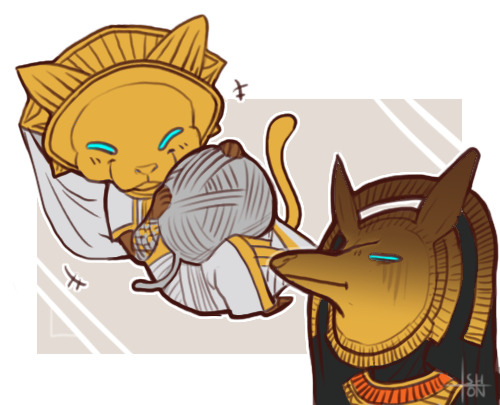
Cat and Jackal Gods | Original art by @isharton
Welcome to another issue of the MTG Tumblr Recap! Thanks to those who have followed us, and now the new-set season is in full swing, we hope to be getting into a proper groove that keeps this thing happening on a normal, weekly basis. For those unfamiliar with what we do, the MTG Weekly Tumblr Recap is a gathering of some of the most notable posts and trends from within the MTG Tumblr community for a given week. For this issue, we will be covering things from the end of March, 2017 through April 3, 2017. If you are interested in joining our writing team, please PM any of our writers and we will add you to our Discord.
1. In-Vocational Training
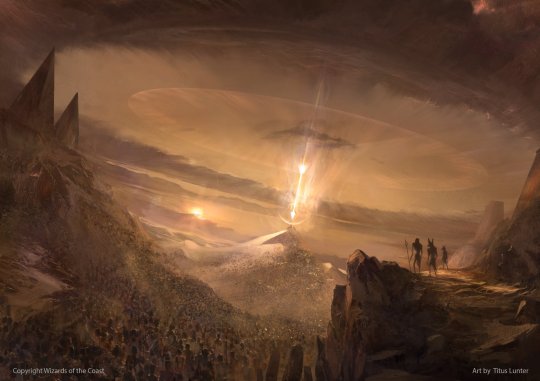
Art for Wrath of God | Original art by Titus Lutner,
The new Masterpiece series for the Amonkhet block was revealed earlier last week. These cards inspired much discussion throughout the Magic Community. The new Masterpiece cards are unlike any of the Masterpiece cards that Wizards has released. While Zendikar had Expeditions and Kaladesh had Inventions, Amonkhet will have Invocations.Some of cards being printed are iconic cards, such as Counterbalance, Daze and Wrath of God. They have gorgeous, beautiful artwork inspired by the Plane, however, the rest of the design of the card has brought about some criticism from the community. The main criticism of the cards are that they are difficult to the read, due to the font used for the letters and the incorporation of “hieroglyphics”. Mark Rosewater has said that this approach was inspired by the Elesh Norn promotional card, that used the Phyrexian language. However, the font and “hieroglyphs” are not legible for some with poor eye sight or other reading impairments, and thus has caused some backlash from the community in regards to this creative choice. @sarpadianempiresvol-viii has also agreed with the majority that the “text is almost unreadable” as well as expressing regret, like others, that the beautiful art is too small to see on the card.
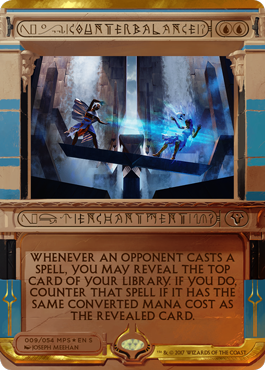
Another main criticism of the Invocations are that they could be considered culturally insensitive. Tumblr user @zoe-of-the-veil has made several posts about this issue. Zoe urges the community to “be aware of this and be careful not to let our enthusiasm for a new set erase these issues and not to let Magic’s #aesthetic contribute to stereotyping and erasing a very real culture.” All in all, there are very mixed reactions of the new Masterpiece series. It is a new approach from Wizards and after Amonkhet is released, the Invocations may have a warmer reception from the Community.
-- Chelsea, @chelsea-beleren-vess
2. This Week’s Magic Story Review
Impact, by Michael Yichao
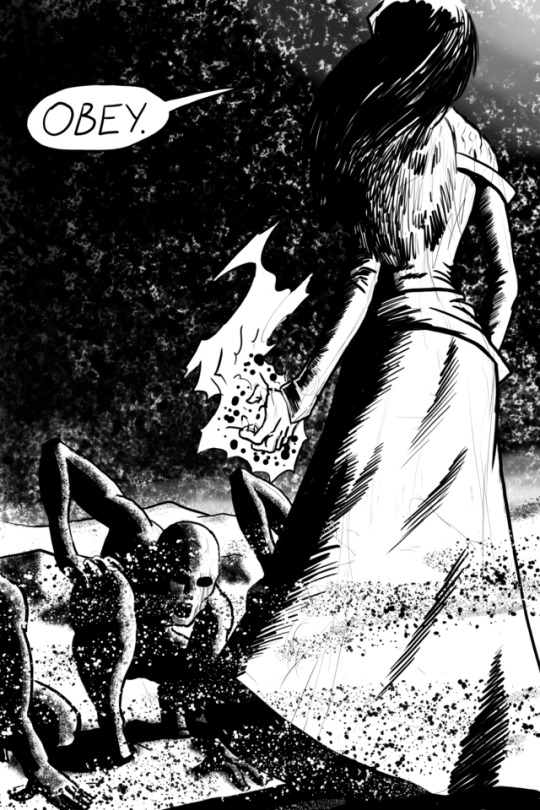
Liliana | Original art by @zomburai
This week we officially kicked off the Amonkhet magic story with the first installment, Impact (written by Michael Yichao, author of Sacrifice, All the cairns of Jund, and Quiet Moments)! The story shows the Gatewatch’s (minus Ajani, the only member who thought charging into Bolas’s private realm without a plan wasn’t such a great idea) arrival on Amonkhet and its… not-so-fun experiences with the local climate and fauna. Yichao juggles the different points of view of the five planeswalkers very well, often switching up the style of narration while simultaneously giving us the possibility to see what’s going on in the planeswalkers’ minds and how they often have very different perceptions (Chandra, for example, thinks the other four are wimps who can’t stand a little heat).
The first story of a block is always crucial in that it needs to establish a starting point from which to go forward but also needs to provide more than just a “this is where the story will take place” feel, because otherwise it will not be as entertaining as the following installments: it needs to have some action and/or lay out a basis for conflict. Impact accomplishes this not only by having the gatewatch fend off zombies and sandworms, but also by showing us how the journey ahead of them is all but simple: not only were they all about to die without Bolas even lifting a finger, but we see that Liliana has other plans (namely, Razaketh) and Gideon is awe-struck by the presence of Hazoret and, by extension, the other gods (which could lead to some interesting character development on his part). In summary, Impact does a good job of blending fast-paced, action packed narrative with moments of introspection and reflection and a good dose of humor even in the midst of life-threatening situations, and sets the bar pretty high up there for the following magic stories, in terms of narration.
--- Diego, @magus-of-the-color-pie
3. Serpopardon Me?
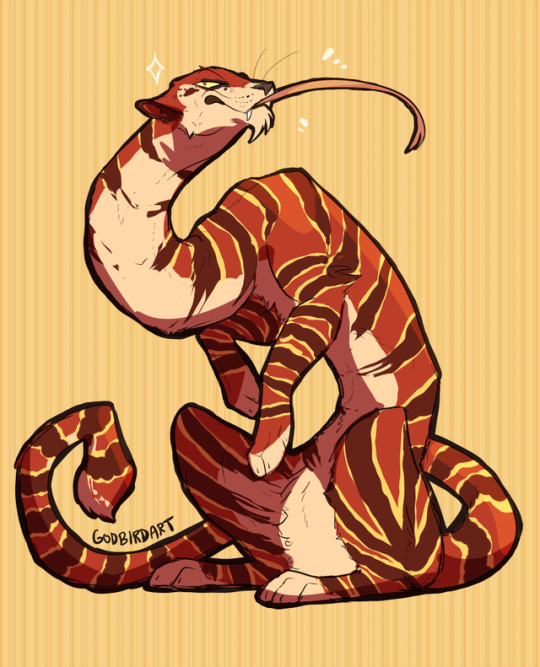
☆ what a good snake. cat. cat snake? snake cat? … cake?? | Original art by @frigidloki
Serpopards (Which some of us discovered are ‘real’ monsters from the Antiquities thanks to @sarpadianempiresvol-viii and Wikipedia) are the big reveal of this weeks pre-spoilers section, and captured the imagination of Magic Fanartists everywhere:

( @isharton )
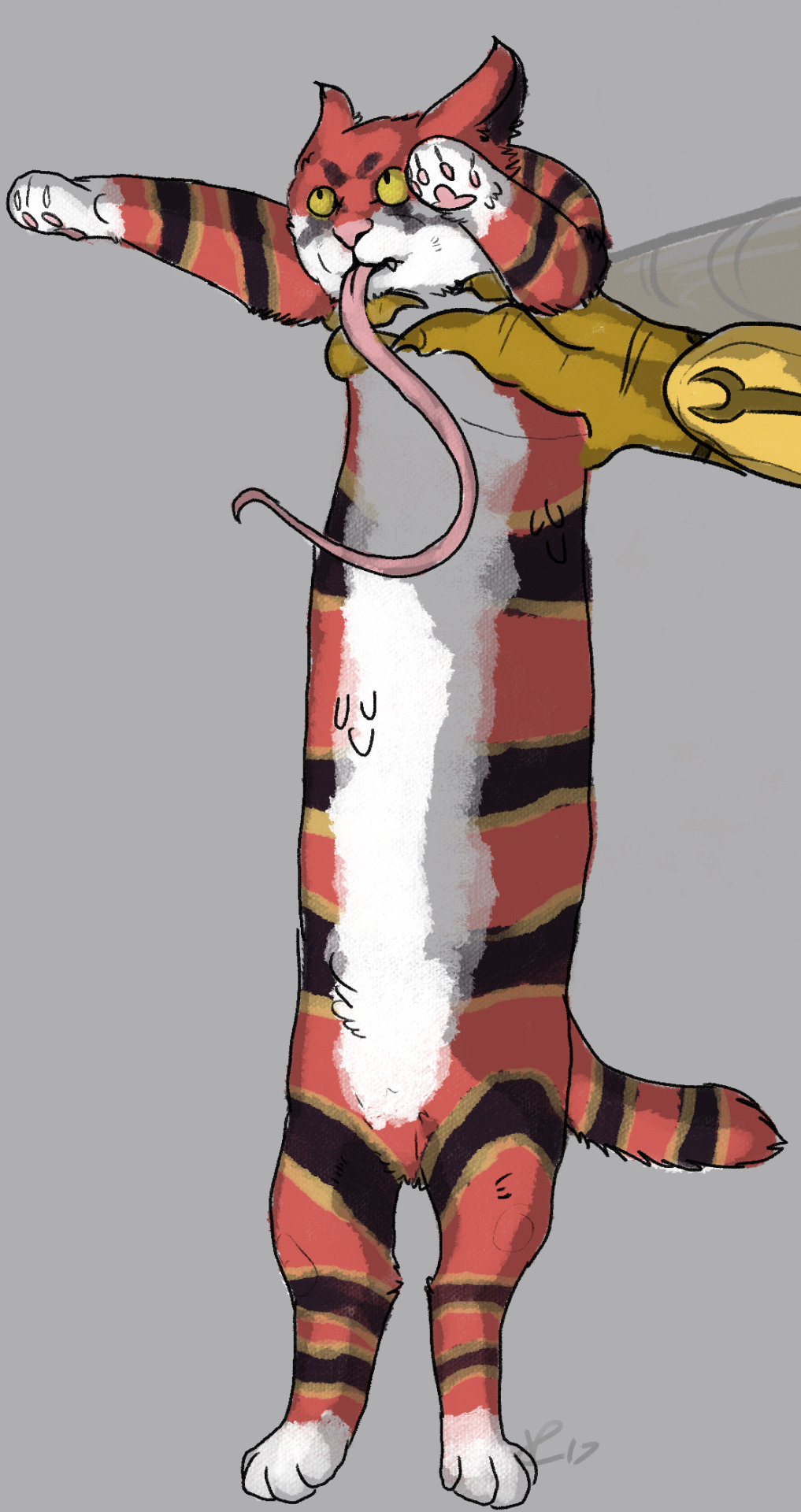
( @oketra )
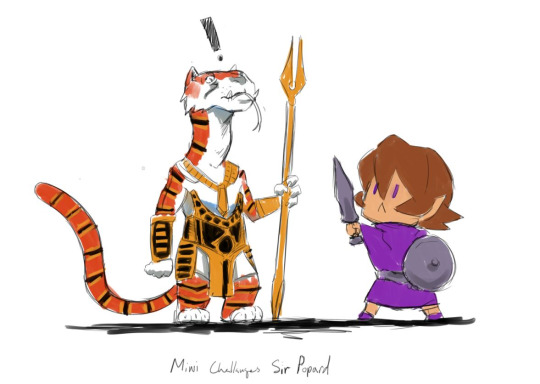
( @pepperjaq )
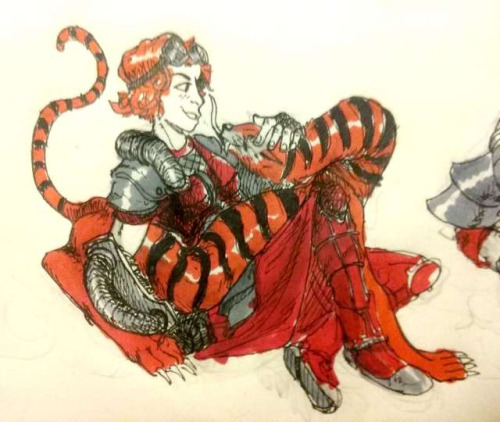
( @trans-chandra )
--- Compiled by Diego, @magus-of-the-color-pie
4. Pre-Spoiler Week Spoiler-y Previews!
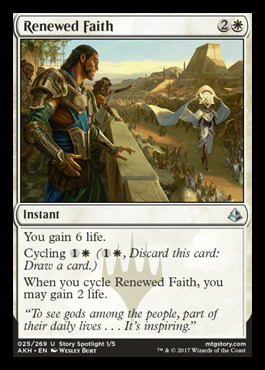
Renewed Faith | Original art by Wesley Bert
We sit in the eve of a great, new spoiler season, and like always, Wizards cant help but set their phasers to ‘tease’ as they give us glimpses of the new set before the official fortnight of fun. In addition to the polarizing Invocations, a couple of cards have been previewed, including quite a few for the Gideon and LIliana Planeswalker decks, the cards confirmed for the set proper have some interesting new mechanics, showing the return of Cycling as mechanic, as well as introducing Exert and Embalm
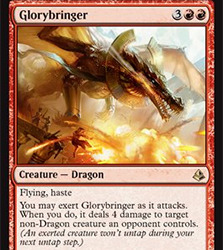
Glorybringer | Original art by Sam Burley
Exert is an ability that comes into play when you declare attacking. For the low low cost of not untapping on your next untap step, you can give a creature with the exerted creature a bonus. So far we’ve only seen the card above, so we don’t know much about which colors will have this ability.
Embalm is another ability word, allowing cards to be copied as tokens from the graveyard, for a mana cost and exiling the original card. The token copy is alway white in color, and always a Zombie (mummy) creature, in addition to it’s other type, but appears to be identical in all other ways. Although the below example is white, it would seem that this ability will not be limited only to that color.
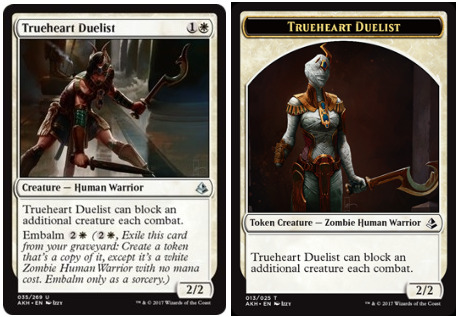
Trueheart Duelist | Original art by Izzy
--- Liam, @coincidencetheories
5. FAN ART AROUND THE BLOGS

Dark Power | Original art by @diorevoredo
You’ve no doubt seen some of these making the rounds, but they’re awesome and this here blog’s looking to celebrate awesome.
@isharton gave us a look at Amonkhet from the perspective of a humble brick, while @hirfael took a quote from Impact where Gideon rescues Jace with one hand.
@zurgo-nerdpuncher meanwhile, couldn’t be more excited about the confirmation of snakes on the plane, and @gemstonechronologist reminds us that fan creations come in many dimensions, with some exquisite fabrications of the Amonkhet Set symbol as a pendant charm
--- Liam, @coincidencetheories
6. Invisible Talker(s)
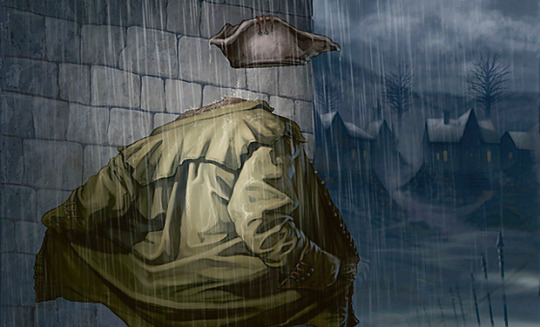
Invisible Stalker | Original Art by Bud Cook
This week, as with most weeks, there were some great Magic podcasts. Of note, you might enjoy:
TapTapConcede - Loading Ready Run : Notable Magic Tumblr contributor @talinthas was this weeks guest, talking about Kaladesh’s cultural influences, as well as the odd faux pas.
Limited Resources - Marshal Sutcliffe and LSV: A blast from the past as original co-host and current Wizards employee Ryan Spain drops by The Girlfriend Bracket - Erin, Hallie, Kriz and Katie: As this podcast nears it’s 100th episode, the gang talk about the ‘grind’, and other goings on in Magic. The Command Zone - Jimmy Wong and Josh Lee Kwai: Learn some ways to mix up your playgroups game of Commander
--- Liam, @coincidencetheories
...and finally: Amonkhet Tumblr Awards
@mtg-weekly-recap contributor @chelsea-beleren-vess had the idea that we as a community might give some votes on the new set (and new sets going forward) and people have taken to the idea, giving suggestions for a few other categories to make a real red-carpet event. Feel free to let her know any other ideas for the categories you want to see! Also, stay tuned once Spoiler Season is complete for details as to how to vote for your favorites!
Thank you again for reading this week’s issue of the MTG Weekly Tumblr Recap. Hope to see you next week! Interested in contributing to the Recap? Want to keep track of notable posts and trends throughout the MTG community on a given week? Or write a short blurb on a specific topic? Do you just want to make us aware of one specific topic or post? Please PM our main editor @the-burnished-hart or any of our staff writers!
#mtgwtr#mtg weekly recap#mtg weekly tumblr recap#mtg#magic the gathering#amonkhet#invocations#serpopard
61 notes
·
View notes
Text
Missed Opportunities Commentary
Thank you all, once more, for a fantastic week. I wish my schedule allowed me to do this more often, since it really is so much fun. Now, then, let’s get into it! All 14 remaining submissions are under the cut, card and commentary included.
We’re going to be going in reverse alphabetical order this time, so let’s start it off with @shadowtag‘s submission, Traumatic Reunion
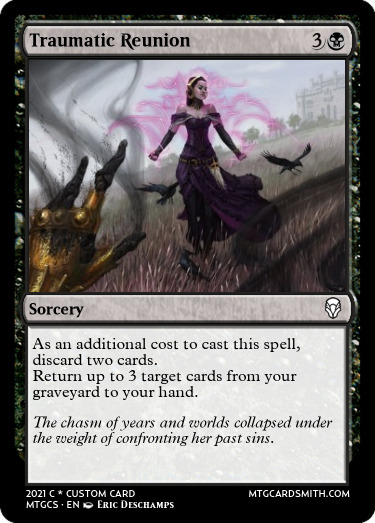
This is an absolutely beautiful callback to Cathartic Reunion in both function and flavor, but this is not a black effect. The only color allowed to return any card type from their graveyard to their hand is green, and spells that return multiple cards at once all exile themselves (or otherwise remove themselves from your graveyard like Seasons Past.) Very good job on the flavor, but unfortunately the mechanics don't quite pull through.
@misterstingyjack Tocasia’s Ingenuity
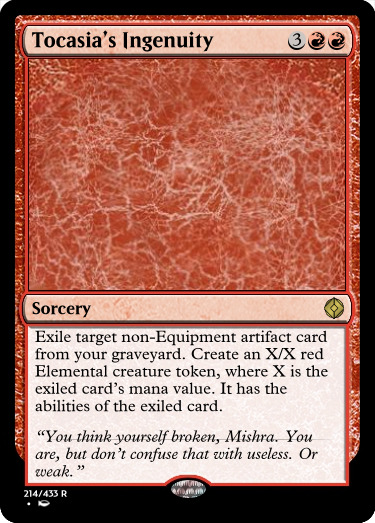
A deep pull to be sure, but not an unwelcome one. Although, given that Primal Plasma is blue, and blue is the central overlapping color between Urza and Mishra, I don't see why this wasn't a blue card. The fact that it makes a token with all the abilities of the card is strange to me too, as with Soul Separator from Shadows Over Innistrad there is precedent of making token copies of things in graveyard with different characteristics. That aside, an artifact focus was 100% the right direction to take here, even with the Elementalist spin, and the card is well balanced, all things considered. Unrelated to the judging, you mentioned Darksteel Colossus in the notes, but unfortunately that wouldn't work. Darksteel Colossus shuffles itself into your library if it would be put into a graveyard, so it's impossible to interact with it in the graveyard (Blightsteel Colossus does this as well.)
@i-am-the-one-who-wololoes The First Battle

I always love to see the Demon Leviathan given the attention it deserves. The lore on this is absolutely wonderful, but it's also way too much text to put on a Saga. If it did fit, I'd suggest swapping the first two chapters so that you can better set up the killing blow, but as it is I think it should just be an instant or sorcery that makes the planeswalkers fight and adds the counters immediately.
@ozthearistocrat Mistmeadow Jack
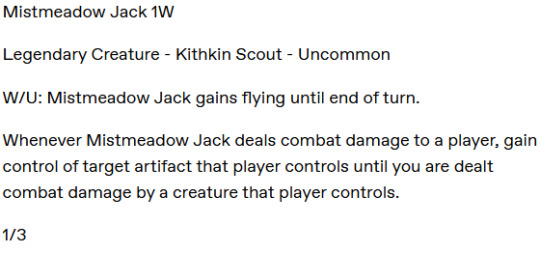
I also had to look this one up, and flavorfully I'm liking what I'm seeing! Unfortunately, this is not a white card. Stealing things, even temporarily, is not a white effect. If this card were blue to cast with a white activation (or keeping the hybrid activation) it would have been perfect.
@snugz Khanfall
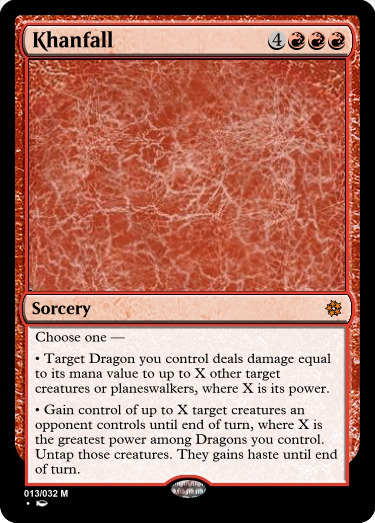
Choices were a big part of Fate Reforged, and Khans block in general, so it makes sense that a splashy mythic set in that time would have a choice attached as well. However, given that the card is named Khanfall, and there's only one way that can go down, it seems strange to me that there's a choice at all. The mechanical aspects of this card are wonderful, but I think it should have done only one of these things rather than try for both.
@starch255 Hyperi, Titan of Sky’s Tyranny
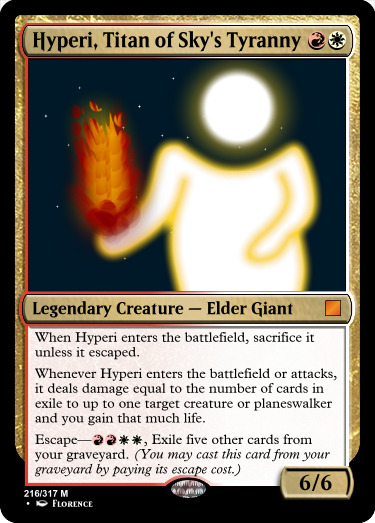
I'm definitely a fan of the concept, and I'm glad you caught on and made the Helixing optional, but my feelings on Hyperi are mixed. The two Titans we have fit into a playstyle of "Good spells on turn 2/3, good value engines later in the game," but Hyperi doesn't. It's an absolutely backbreaking card late game, especially since grave hate powers up future versions, but on curve it most likely does nothing at all. You would have been better served making it either flat damage + lifegain or tied to a number other than cards in exile.
@gollumni Hurrik, Savior of Gods
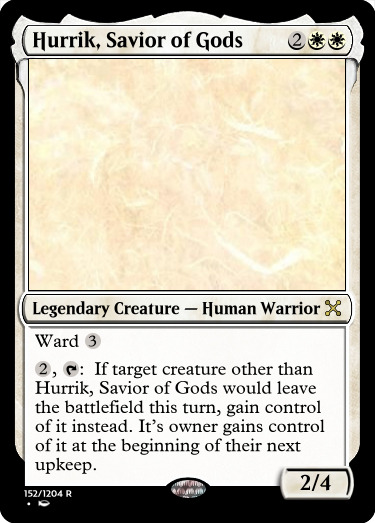
There's a lot to say here, so let me start by assuring you that I really wish this card worked. If you activate this and target any creature that then dies to damage or 0 toughness, it creates an infinite loop of replacement effects that ends the game in a draw, because it doesn't remove marked damage or debuffs, so the creature will die again to state based actions so the replacement effect, which lasts until the end of the turn, will grab it ad infinitum. If it said "the next time" and removed damage, or it exiled and brought it back under your control, then it would work perfectly. It also saves your own creatures without the downside, which I don't think was intentional based on the wording.
@hypexion Hack the Guildpact

Maybe I have a skewed experience with this sort of thing, but this looks very easy to win with. If you have even three unique color pairs and a proliferate card, you'll win in three turns. But worse than that, the card doesn't do anything aside from winning the game. If it gets to 9 counters and then gets blown up, it didn't do anything. Cards which say "win the game" on them usually have either some sort of protection, like Helix Pinnacle and Darksteel Reactor, or some other effect to help win or survive, like Approach of the Second Sun and Simic Ascendancy. Maybe it could have a ramping scry/surveil based on the number of counters, and then win at 10.
@teaxch Gvar, Krumar Commander
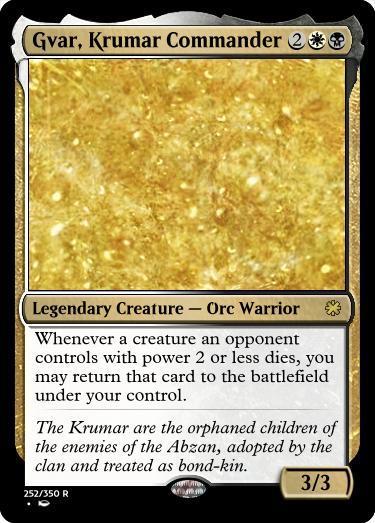
It's simple and clean, although it doesn't quite carry the same flavor as what the Krumar really are. The mechanics of this card imply that they defeat the children and then take them, and although the flavor text describes it properly, it's still at odds with the functionality. A better way to do this might be to follow the example of Offspring's Revenge, and have Gvar make 1/1 token copies of opponent's creatures that die, with appropriate stat balancing.
@bread-into-toast Glimpse of Perfection
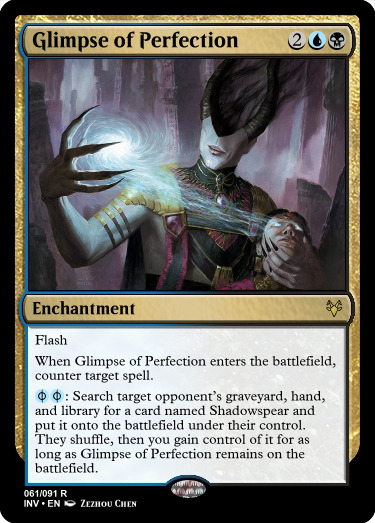
I get what you were going for, and I like it, but it's messy. It's a counterspell and a stealy card, but the fact that it namedrops the Shadowspear specifically means it's very niche, and the fact that you're paying more than usual for the counterspell, and then 4 life (or UU) for a 1 mana artifact that you don't always keep forever makes the card underwhelming even when it does work. I think a better way to accomplish this flavor would have been to make both the counterspell and search effect on etb, and make the steal effect search for any artifact with mana value 1 or less.
@morbidlyqueerious Glimpse Beyond

Mechanically, this card is perfect. Blue and green are the perfect combination of colors for this effect, weaving together cards like Commune With the Gods and Investigate the Mystery seamlessly. My only gripe is that, looking at this without the flavor text, I would not know what it's representing. It's a great effect, and I do love me some Rashmi, it's just a little too nonspecific.
@shakeszx Dack’s Fate

Very on the nose. Normally, most things about this card would be working against it, but in the specific context of War of the Spark, it fits very well. Legendary sorceries would have been great in a set with 36 planeswalkers, as well as planeswalker specific removal. I'm not sure why this is white, though. Nicol Bolas has never been associated with white, least of all the Eternals, and everything this card does can be done in mono black.
@wolkemesser Clockworking

Mechanically, this card is fine. I think it should have been a delayed trigger to choose one ("when you win" instead of if), and the "use" should be changed to "activate" but the card works as written. Apart from that, the effects are of wildly different power levels (compare Raise Dead to Disallow). Flavorfully, I'm very confused why you re-used a Lorwyn mechanic for the Scars of Mirrodin story, let alone one as divisive as Clash.
@col-seaker-of-the-memiest-legion ______, Planeswalker
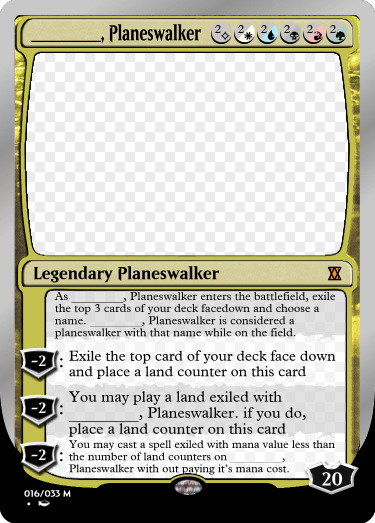
This is a wonderful example of a card that is only silver bordered due to flavor. It functions exactly as intended in black border, without any changes to the rules or mechanics of the game, but is still a card that would never be printed outside of an Unset. That being said, the card itself does need a bit of a templating update. It needs to specify that you can look at cards exiled with it, otherwise you won't be able to play any of them, and I assume you meant for the last ability to be less than or equal to the number of land counters on the Planeswalker. Mechanically, there's a few changes that would need to be made to get it to the right spot in terms of balance. The cost, for one, is a mess. Twobrid mana isn't used anymore for good reason, and while I understand the intent behind its use here, it drags the design down. The fact that all of the abilities subtract loyalty means that even though it starts with 20 counters, you're likely not going to be able to play anything off of it. It playing the land in the second ability is more restrictive than you might assume, since the opportunity cost there is both drawing a card into the planeswalker and your own land drop for the turn.
~
And that will do it for us today! It was a genuine pleasure to host this for you all, and I look forward to the next time our paths cross in such a manner.
-Mod @illharg-the-rave-boar
11 notes
·
View notes
Text
2020 Commander Products
Well, they promised us something big for Commander for 2020, and boy did they deliver. After this announcement, I’m beyond stoked for what next year is going to bring us in terms of goodies for our favorite format. Today, I’m going to just really quickly run through what products they’ve announced, and my thoughts for each. For the full rundown from Wizards, head to the mothership here: Big Things are Coming for Commander.
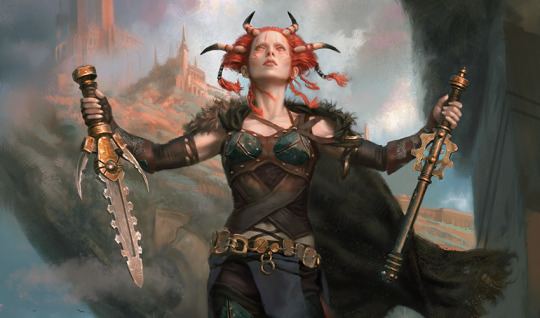
Commander 2020: Ikoria, Lair of Behemoths
So, first thing on the docket for next year, as far as Commander is concerned, is the Commander 2020 product. The big news here is that this time around, they’re going to tie the annual Commander release to the Spring set: Ikoria, Lair of Behemoths. These decks will focus heavily on new cards, just like previous Commander releases. So here’s what that means:
No Planeswalker Decks for Ikoria
New Legendary Creatures will all be flavored from Ikoria
The decks will center around Ikoria mechanics
Honestly, I like this quite a bit. This feels like the evolution of the four Eldraine Brawl decks, all of which were honestly pretty great. They also announced that for this release, they would go back to 5 decks, rather than 4, which honestly makes more sense anyway. Magic is built around the number 5.
As for no Planeswalker Decks, I can say I truly will not miss them. They always felt like a product designed for no one, because they’re not good enough to play as 60 card constructed (despite what Wizards said), but they also didn’t have enough playable singles in them to draw other players to buy them (with a few rare exceptions). So the only people who bought them were crazies like me who have completionism issues. Also, having “powered down” Planeswalkers was really... lame. It just made the coolest card type in the game feel more common (not as in rarity, as in un-special) and again, lame. So good riddance having Planeswalker decks with every set. Wizards has said that the Core Set release next year will have them, but honestly, the Core Set is where they belong. We don’t need them with every set.
The only thing I’m not sure about is if the Commander release being tied to a set will get restricting, if they intend to do it this way in future years. I really like the idea of Commander decks tied to specific planes in smaller numbers, but it is nice to have the major release that can pull from all of Magic’s history to find characters. So, given that they have a giant release at the end of 2020 specifically to address this need, I think having the set-themed ones for the main release will be fine. For future years, they’ll have to figure out that balance.
Commander Decks: Zendikar Rising
After the Summer Core Set normalcy, the Fall set Zendikar Rising will bring two Commander decks tied to it, also replacing the Planeswalker Decks for that release. These two decks will have more reprints and only a few new cards, so they’ll really be more “introductory” products, similar to Brawl decks or Planeswalker decks, which could be seen as a happy middle.
From the sound of it, the Zendikar Rising approach is what they are planning to use as the mold for most non-core sets going forward. Sets will come with 2 decks (maybe alternating Commander & Brawl?), with some focus on the themes of that set and providing some good reprints. That last piece is encouraging, because one of the issues with Planeswalker decks is that they are not a method to reprint needed staples, whereas these Commander decks might be.
Commander Collection: Green
Coming sometime slightly after the Zendikar Rising Commander decks will be a box set called Commander Collection: Green. From the sound of it, this will be the equivalent of the Signature Spellbook series, but I don’t think they confirmed if this is meant to replace those or if they will actually do both next year.
My hunch is they’ll only do the one, since there is only so much appetite for limited-print box sets every year. The good news is that they understand the audience who is looking for pimped out cards is mostly Commander, so focusing the cards on what’s playable in that format will serve them better than, for example, Signature Spellbook: Jace, which seemed to focus on cards for 60-card formats. The one thing I don’t like about this is that they plan to have a “normal” version and a “premium foil” version, which really just feels like a cash grab. I liked having the one random foil that they did in the Signature Spellbooks.
Of all the announcements, this one feels the most like a mixed bag to me.
Commander Legends
Of all the announcements, this one is the big one. A full 200+ card set, designed for drafting, AND designed for Commander players. 70 new Legends! A foil in every pack! Reprints! New Cards!
This is something a lot of Commander players have been requesting for years, and it sounds like a bunch of fun. I mean, Draft and Commander are the two best formats, what could possibly go wrong combining them? (The sarcasm was intentional, but truly, I am optimistic about this.)
Commander Legends will be next year’s innovation product, so that means it fills the slot that Battlebond, Conspiracy, and Modern Horizons have filled in recent years. What excites me about this is that it means there’s a huge opportunity here for them to add tons of copies of desperately needed reprints into the market, all in one go, and it honestly just sounds like a blast.
Final Thoughts
Okay, so now I just want to recap my general feelings about next year.
On the one hand, I’m really stoked about this suite of products. The single biggest issue for Commander as a format is that its popularity has produced a situation where Wizards has been unable to effectively manage the price of many important staples, pushing the format out of reach. The presence of more products in the year geared towards Commander will give them more opportunities to address that issue and put more reprints into the market.
On the other hand, the added emphasis on Commander will draw more people into the format, especially on the heels of the big Brawl push this year, and as more people who started playing on Arena transition to paper. So, the downward push on prices could be countered somewhat by an upward push in demand. Only time will tell on that one.
Back on the positive side, all of these products seem like a lot of fun (minus the Commander Collection, which sounds less “fun” and more “cool”). I’m looking forward to the themed decks coming out with Ikoria and Zendikar, and I’m really looking forward to drafting Commander Legends. Commander is going to be big next year, and I’m all for it.
The final less positive note, though, is that it is going to continue being hard to track and remember what products are coming with what sets. I mean, here’s the lineup:
Theros: Beyond Death - 2 Planeswalker Decks
Ikoria: Lair of Behemoths - 5 Commander Decks
Core Set 2021 - 5 Planeswalker Decks
Zendikar Rising - 2 Commander Decks
And remember, the Zendikar Rising Commander decks are different from the Ikoria Commander decks. Fewer new cards, different packaging, and likely not as pushed in terms of value. But not everyone will understand that.
And this is just next year. What comes after? Is every set going to get its own accompanying product that’s different every time? What is the logic or pattern to what sets will get what products? And will the dedication to providing necessary reprints continue after this flood in 2020?
So basically, I have a lot of questions. Personally, I think it would benefit Wizards to come up with a dedicated release schedule. Say what you will about Masters sets, at least they had some familiar predictability to them. Personally, my preference would be to have each set come with 2 Brawl decks (5 for Core Set), completely eliminate Planeswalker decks, then to have a separate Commander release of 5 decks once a year, unattached to a specific set. That, plus an innovation product every year, should be enough to provide enough new cards to get players excited, but also provide enough of the reprints they so desperately need.
In any case, I’m excited for next year. I hope these products do well, as much as I hope for Wizards to figure out a routine release cadence for them.
1 note
·
View note